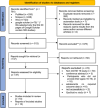Adolescents' Sexual Health During the COVID-19 Outbreak: A Systematic Review
- PMID: 40309618
- PMCID: PMC12040736
- DOI: 10.1002/hsr2.70774
Adolescents' Sexual Health During the COVID-19 Outbreak: A Systematic Review
Abstract
Background and aims: The COVID-19 pandemic has greatly disrupted adolescents' access to sexual health services, resulting in a decline in their overall sexual well-being. This systematic review explored adolescent sexual health during the COVID-19 pandemic.
Methods: A systematic review of quantitative studies-including observational research, clinical trials, and quasi-experimental interventions-examined English-language articles published between January 2020 and February 10, 2025, sourced from databases such as PubMed, Web of Science, Scopus, and Google Scholar. Study quality was evaluated using the Newcastle-Ottawa Scale (NOS) for observational studies, Cochrane RoB 2 for clinical trials, and ROBINS-1 for quasi-experimental designs. Due to the heterogeneity of the data.
Results: After identifying 781 articles, 10 studies with a total sample size of 636,873 participants were included in the final systematic review. Observational studies during the COVID-19 pandemic revealed diminished access to sexual and reproductive health (SRH) services, greater dependence on informal information sources, widening health inequalities, and negative impacts on adolescent sexual behavior. Intervention studies on online SRH education demonstrate significant positive impacts across key areas: access to SRH services, safe sex practices, communication with parents about sexual health, lower acceptance of dating violence, normative beliefs regarding adolescent sexuality, HIV/STI awareness, and condom use. The findings emphasize notable improvements in communication, knowledge, and attitudes toward sexual health, driven by these targeted interventions.
Conclusion: The COVID-19 pandemic disrupted adolescent SRH globally, reducing service access and amplifying inequities. While some behaviors (e.g., sexual activity) showed resilience, systemic gaps in education and healthcare persist. Multisectoral efforts are needed to ensure adolescents' SRH rights are upheld during crises. However, the interventional studies underscore the viability of digital, media-literate interventions in improving adolescent sexual health.
Trial registration: The review study was officially registered on the PROSPERO website on 02/08/2023 under the code CRD42023438631 and received approval from the jury.
Keywords: 2019 nCoV infection; SARS coronavirus 2 infection; sexuality; teenager; youths.
© 2025 The Author(s). Health Science Reports published by Wiley Periodicals LLC.
Conflict of interest statement
The authors declare no conflicts of interest.
Figures
Similar articles
-
"I am not shy anymore": A qualitative study of the role of an interactive mHealth intervention on sexual health knowledge, attitudes, and behaviors of South African adolescents with perinatal HIV.Reprod Health. 2022 Dec 1;19(1):217. doi: 10.1186/s12978-022-01519-2. Reprod Health. 2022. PMID: 36457044 Free PMC article. Clinical Trial.
-
A qualitative assessment of the impact of a community-embedded intervention on beneficiaries' attitudes and beliefs about adolescent sexual reproductive health in Ebonyi State, Southeast, Nigeria.Reprod Health. 2024 Jan 11;21(1):5. doi: 10.1186/s12978-024-01738-9. Reprod Health. 2024. PMID: 38212841 Free PMC article.
-
Impact of the COVID-19 pandemic on the sexual and reproductive health of adolescents in Alberta, Canada.Reprod Health. 2023 Nov 22;20(1):172. doi: 10.1186/s12978-023-01712-x. Reprod Health. 2023. PMID: 37990327 Free PMC article.
-
Parent-adolescent communication on sexual and reproductive health issues and its associated factors in Ethiopia: a systematic review and meta-analysis.Ital J Pediatr. 2020 Oct 30;46(1):162. doi: 10.1186/s13052-020-00921-5. Ital J Pediatr. 2020. PMID: 33126919 Free PMC article.
-
A systematic review of effective parent-adolescent sexual and reproductive health information communication in lower- and middle-income countries.Health SA. 2023 Sep 29;28:2435. doi: 10.4102/hsag.v28i0.2435. eCollection 2023. Health SA. 2023. PMID: 38076672 Free PMC article. Review.
Cited by
-
Impact of layered behavioral, socio-economic and school-based interventions on selected behavioral and biomarker indicators among adolescent girls and young women in Uganda.PLOS Glob Public Health. 2025 Jun 24;5(6):e0004819. doi: 10.1371/journal.pgph.0004819. eCollection 2025. PLOS Glob Public Health. 2025. PMID: 40554576 Free PMC article.
References
-
- Bonagani R. R., “World Health Organization's Responsive Policies for the Containment of COVID‐19 Pandemic in the World: An Analysis,” 2022.
-
- Sandín B., Valiente R. M., García‐Escalera J., and Chorot P., “Impacto Psicológico De La Pandemia De COVID‐19: Efectos Negativos y Positivos En Población Española Asociados Al Periodo De Confinamiento Nacional,” Revista De Psicopatología y Psicología Clínica 25, no. 1 (2020).
-
- COVID‐19 National Incident Room Surveillance Team , “COVID‐19, Australia: Epidemiology Report 19 (Fortnightly Reporting Period Ending 21 June 2020),” Communicable Diseases Intelligence (2018) 44 (2020): 44–54.
Publication types
LinkOut - more resources
Full Text Sources
Miscellaneous


